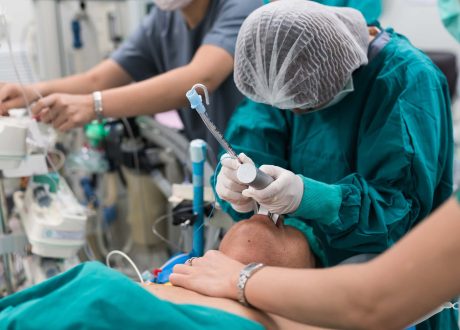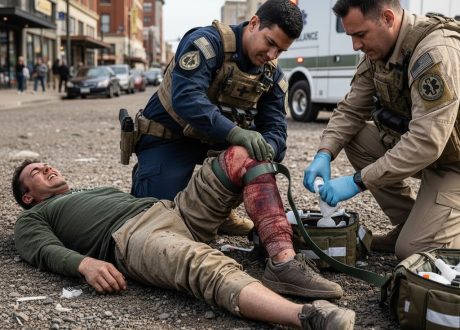Written by Clay Smith
Spoon Feed
The American Society of Anesthesiologists (ASA) has released new difficult airway guidelines that replace the 2013 version. Here’s what you need to know in the ED.
Why does this matter?
We’ve covered reviews on managing the difficult airway before. But what are the latest official guidelines from the ASA?
“Everyone has a plan until they get punched in the mouth.” Mike Tyson
I will summarize the ASA guidelines in this section, but I present an abbreviated, more pragmatic version that I actually use in practice at the end.
1) Evaluate in advance for a difficult airway (when feasible)
Often we can’t do this in the ED. But if you anticipate a patient may need an airway or as part of a pre-sedation assessment, consider these.
-
History – prior difficult airway, distorted airway†, prior head and neck radiation therapy, snoring, medical /surgical /anesthetic history, risk of aspiration (NPO time).
† Do you have a recent CT or other imaging you can review? -
Airway exam – mouth opening, ability to prognath (push mandible forward), head/neck mobility, prominent upper incisors, +/- beard, and upper lip bite test.
-
Measurements – modified Mallampati score, thyromental distance, sternomental distance, interincisor distance, neck circumference, and more. The value of these is questionable, at least Mallampati.
-
POCUS – skin-to-hyoid distance, tongue volume, and distance from skin to epiglottis.
2) Prepare in advance for a difficult airway
-
This should go without saying, but have all the basic equipment out to suction, bag, oxygenate, intubate, and sedate/paralyze.
-
Plus have all the equipment in the room (usually in the form of a difficult airway cart) in case of a difficult airway: supraglottic airways (SGA), scopes, cric kits, jet ventilation set up, and much more.
-
Have an experienced person in the room.
-
Optimize patient and operator positioning, pre-oxygenate, use apneic oxygenation.
-
Make sure all monitoring equipment is in the room and ready.
-
This isn’t mentioned in the guideline, but find and mark the cricothyroid membrane (CTM), using palpation or POCUS, ahead of time.
3) Managing an expected difficult airway
-
If history or exam indicate a possible difficult airway and you have time, call for help. In the ED, there is no room for hubris. Anesthesia is your friend; call them if your patient is still relatively stable and you see obvious trouble ahead.
-
Strongly consider an awake intubation approach if you suspect a difficult airway. This is repeatedly emphasized in this guideline. This doesn’t work in some uncooperative patients or children. See below for step by step details on awake intubation.
-
Start with a videolaryngoscope (VL). Forget direct laryngoscopy (DL).
-
Have a prespecified plan if things go sideways: bougie; hyperangulated VL; flexible intubating scope; lighted stylet; combination of the above; bag-mask ventilation; SGA placement
-
BE MINDFUL OF HOW MUCH TIME HAS ELAPSED; limit number of intubation attempts; watch SpO2
-
Move to emergency invasive approach if in a can’t intubate/can’t ventilate situation. Consider ECMO if invasive approach fails.
-
In the ED, really every airway is expected to be difficult, but some are more apparent. Always be ready. Avoid hubris.
Managing an unexpected difficult airway
-
Since most emergency physicians expect every airway will be difficult, this is not much different than the above for most of us.
-
The key is, as above, to have a pre-specified, rehearsed plan in place beforehand. As above, be aware of elapsed time; limit attempts; and watch the SpO2.
Confirm intubation
-
You have to confirm the tube is in with capnography.
-
If no CO2, you must quickly decide on tube removal and alternate ventilation techniques.
Thoughts on extubation
-
There is a whole section on extubating patients with a difficult airway. This makes sense in an OR setting, post-procedure, but this should just be avoided in the ED. Just intubate people; don’t extubate them.
-
There are rare times we might extubate in the ED. I set up for an extubation just like for an intubation, because you very well might have to re-intubate them. Be ready with all the gear and drugs.
Simplified Steps
This is my version of the ASA guidelines with only the stuff that is important and relevant for the ED.
Evaluate in advance
-
History: prior difficult airway, distorted anatomy, snoring, recent neck CT?
-
Exam: mouth opens, neck moves, bearded or not, upper lip bite score
Prepare in advance
-
Have routine equipment out and difficult airway cart in the room.
-
Call in the best people you can. That may be you.
-
Position, pre-oxygenate, and give apneic oxygenation.
-
Mark the CTM.
Managing a difficult airway
-
Call for help (if you can) in an anticipated difficult airway.
-
If you anticipate a difficult airway, consider awake intubation (if you can). See below.
-
Here is my standard airway plan
-
Use VL – Intubate.
-
Can’t see cords? Use bougie with VL – Intubate.
-
Can’t pass bougie? Rapidly optimize patient positioning, change something, try hyperangulated VL – Intubate.
-
No view? Come out. Bag the patient. If good BVM seal and ventilation, adjust variables; consider intubating flexible (or rigid Bonfils) scope, SGA, intubating LMA.
-
Can’t bag patient? Place SGA.
-
Can’t place SGA or ventilate?
-
Emergency surgical cricothyrotomy if ≥10-12 years; needle cric if younger. (Exact age is not specified.)
-
-
Watch elapsed time! Limit intubation attempts. Watch oxygen saturation!
Other
-
Confirm EtCO2
-
Don’t extubate people in the ED, especially if they were a difficult airway. Are you crazy?
Awake Intubation, Step-by-Step
This is a bonus and was not in the guidelines. Thanks to EMCrit and Canadiem. Plus I added some things.
-
Identify the right patient – i.e. history or exam strongly suggests difficult airway, high aspiration risk, or difficult front-of-neck emergency invasive access.
-
Pretreat with glycopyrrolate 0.2mg IV 10 minutes in advance (if possible) and ondansetron 4mg IV
-
Prepare all equipment for usual emergency intubation plus prepare equipment for surgical cricothyrotomy, and mark the cricothyroid membrane by palpation or POCUS.
-
Nebulize 4% lidocaine at 5mL at 5 L/min flow (larger particles – more in pharynx, less in lungs)
-
Gargle viscous lidocaine or 2% lidocaine jelly. Spit out or swallow.
-
Consider anxiolysis with low-dose midazolam, subdissociative ketamine (0.3mg/kg IV), or dexmedetomidine (0.5-1 µg/kg over 10 minutes and 0.2 – 1 µg/kg/hr infusion).
-
Dry mouth with gauze and suction all saliva.
-
Introduce VL. Use mucosal atomization device on flexible tubing (i.e. MADgic® device) to spray 4% lidocaine solution directly on posterior pharynx, on vocal cords, and even through vocal cords using VL visualization.
-
Introduce bougie until it is near the cords. Push intubating-dose ketamine or ketamine/propofol mixture. Pass the bougie.
-
Intubate.
Source
2022 American Society of Anesthesiologists Practice Guidelines for Management of the Difficult Airway. Anesthesiology. 2021 Nov 11. doi: 10.1097/ALN.0000000000004002. Online ahead of print.








